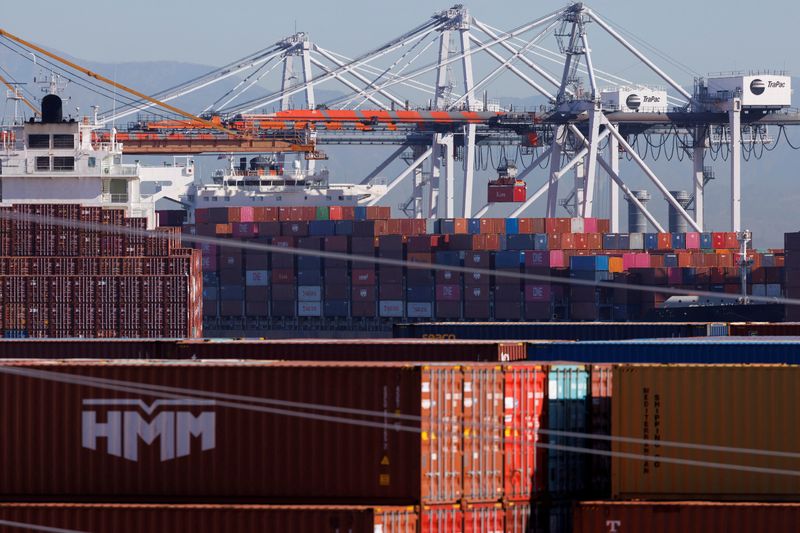By Lucia Mutikani
WASHINGTON – The U.S. trade deficit in goods widened sharply to a record high in January amid an increase in imports as businesses continued to replenish depleted inventories.
The pace of inventory accumulation reported by the Commerce Department on Monday was, however, slower than in recent months. That, together with the surge in the goods trade deficit, prompted economists at Goldman Sachs to lower their gross domestic product growth estimate for the first quarter by 0.5 percentage point to a 1.5% annualized rate.
The economy grew at a 7.0% pace in the fourth quarter, with inventories contributing a whopping 4.90 percentage points.
“We remain on track for another strong gain in real business inventories in the first quarter, although inventories may end being fairly close to a neutral factor for GDP growth considering that the fourth quarter buildup of inventories also was substantial,” said Daniel Silver, an economist at JPMorgan in New York.
The goods trade deficit jumped 7.1% to an all-time high of $107.6 billion last month. Imports of goods increased 1.7%, led by food and motor vehicles. There were also large increases in imports of industrial supplies, capital and consumer goods. Imports of other goods, however, tumbled 15.3%.
Exports dropped 1.8%, weighed down by consumer goods, motor vehicles, food and other goods. But exports of capital goods and industrial supplies increased.
Trade has been a drag on gross domestic product for six straight quarters. Economists saw a limited impact on trade from the Russian-Ukraine conflict, which has resulted in the United States imposing same trade sanctions on Moscow. Russia accounted for only 1% of imports and about 0.4% of exports last year, according to government data.
“While the Russian invasion of Ukraine is driving a sharp increase in energy prices, its implications for trade flows will be less noticeable,” said Mahir Rasheed, an economist at Oxford Economics in New York. “Russia and Ukraine make up less than 1% of monthly import volumes and an even smaller share of U.S. exports, so the war has little bearing on the trade outlook.”
U.S. stocks were trading lower as investors assessed the fallout from a raft of sanctions imposed by Western countries on Russia. The dollar rose against a basket of currencies. U.S. Treasury yields fell.
INVENTORIES RISING
The increase in imports last month largely reflected the rebuilding of inventories. Stocks at wholesalers increased 0.8% after climbing 2.3% in December. Inventories of durable goods, items which are meant to last three year and longer, rose 1.0%, while stocks of wholesale nondurable goods climbed 0.5%.
Retail inventories rose 1.9% after jumping 4.7% in December. They were lifted by a 2.4% increase in motor vehicles, which followed a 7.0% surge in December.
Motor vehicle production remains constrained by a global semiconductor shortage. Excluding motor vehicles, retail inventories gained 1.7% after advancing 3.9% in December. This component goes into the calculation of GDP growth.
Inventory investment increased at a seasonally adjusted annualized rate of $171.2 billion in the fourth quarter, one of the largest in years. Growth estimates for the first quarter range from as low as a 0.6% rate to as high as a 5.4% pace.
“Because of the way GDP is calculated, it would require a similarly sized expansion in inventories to contribute that level of growth,” said Matt Colyar, an economist at Moody’s Analytics in West Chester, Pennsylvania. “We do not expect the build in the first quarter to exceed the record-breaking fourth-quarter build. As a result, we expect inventories to subtract 0.3 percentage point off GDP growth.”
Most economists see further scope for inventories to rise, noting that inflation-adjusted inventories remain below their pre-pandemic level. Inventory-to-sales ratios are also low.
Restocking, after three straight quarters during which inventories were drawn down, is supporting manufacturing.
A survey from the Dallas Federal Reserve on Monday showed factory activity in Texas continued to expand in February, though at a slightly slower pace. The survey’s production index, a key measure of state manufacturing conditions, dipped two points to a reading of 14.5.
A reading above zero indicates growth in manufacturing in the region. Despite the moderation in activity, factories reported strong growth in new orders and were upbeat about business conditions. The survey’s general business activity index shot up 12 points to a reading of 14.0.
“The manufacturing sector continues to expand in spite of supply network dislocations and input shortages,” said Rubeela Farooqi, chief U.S. economist at High Frequency Economics in White Plains, New York.
(Reporting by Lucia Mutikani; Editing by John Stonestreet and Andrea Ricci)
